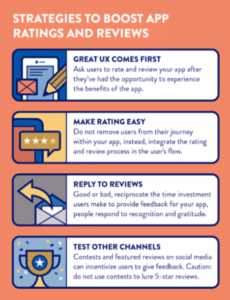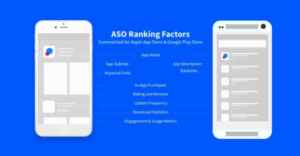App Store Optimization (ASO) is the linchpin of mobile app marketing, a crucial tool that empowers app marketers to enhance their app’s discoverability, amass a larger user base, and boost revenue streams. The statistics, courtesy of Storemaven, speak volumes:
- A strong first impression can up your conversion rates by a whopping 35%.
- Around 60% of visitors won’t explore beyond that initial screen.
- Incorporating an app video can supercharge installation rates by a staggering 25% or more.
Now, let’s dive into the ASO definition and why it’s indispensable for app marketers when crafting their app marketing strategies.
In addition, we’ll equip you with the arsenal of techniques and methods you need to dominate the realm of app store optimization. Whether you’re a newcomer to ASO or a seasoned pro, our guide will be your compass, leading your app to soar higher in app stores.
All about ASO:
- ASO Defined: Unpacking App Store Optimization
- Unpacking ASO: How Does It Really Work?
- Google Play vs. App Store: Crafting the ASO Strategy
- ASO A/B Testing: Fine-Tuning Your Strategy
- Why ASO Is the Holy Grail for App Marketers
- Closing Notes for a Stellar ASO Strategy
1.ASO Defined: Unpacking App Store Optimization
App Store Optimization, affectionately known as ASO, is the art and science of fine-tuning mobile apps to ascend the rankings in app store search results. The ASO mission: to magnify visibility, entice more downloads (nudging that conversion rate from page visitors to app users), and elevate user engagement for a mobile app.
 In the cutthroat landscape of mobile apps, ASO has evolved into an indispensable facet of mobile app marketing. It involves optimizing various elements of an app, from the title, description, and keywords to the icon, screenshots, ratings, and reviews. By carefully calibrating these elements, an app can elevate its prominence in the app store, court a larger user base, and, inevitably, swell its revenue.
In the cutthroat landscape of mobile apps, ASO has evolved into an indispensable facet of mobile app marketing. It involves optimizing various elements of an app, from the title, description, and keywords to the icon, screenshots, ratings, and reviews. By carefully calibrating these elements, an app can elevate its prominence in the app store, court a larger user base, and, inevitably, swell its revenue.
ASO is akin to its web counterpart, SEO, used to refine websites for higher search engine rankings. Nevertheless, ASO caters specifically to mobile apps, factoring in the idiosyncrasies and limitations unique to app stores.
2.Unpacking ASO: How Does It Really Work?
As previously mentioned, App Store Optimization is the strategic overhaul of mobile apps to enhance their visibility and ranking on app store platforms like the Apple App Store and Google Play Store. Let’s delve into the core factors that pull the strings of App Store Optimization:
- App Title and Description: Your app’s title and description should sparkle with relevant keywords that vividly portray the app’s key features and benefits.
- Keywords: The metadata of your app should be studded with pertinent keywords, scattered across the app title, description, and tags. App stores employ these keywords to determine where your app ranks for specific search queries.
- Icon: Your app’s icon should be a visual treat, accurately mirroring the app’s function and features.
- Screenshots and Videos: These visual aids serve as your app’s showcase, spotlighting its functionalities and making it irresistibly appealing to potential users.
- Ratings and Reviews: Favorable ratings and reviews wield considerable influence, lifting your app’s ranking and visibility. It’s paramount to encourage users to rate and review your app.
- Localization: Tailoring your app for diverse languages and regions can substantially elevate its visibility in untapped markets.
- Updates: Consistently infusing your app with fresh features and bug fixes keeps it relevant and propels its ranking upward.
By optimizing these factors, you can hoist your app’s visibility, attract more downloads, and, subsequently, realize higher revenue and growth for your business.
3.Google Play vs. App Store: Crafting the ASO Strategy
 While the core principles of ASO definition and strategy are fairly uniform across both Google Play and the App Store, nuances set the two platforms apart in terms of strategy and techniques. Below, we illuminate key distinctions between ASO for Google Play and the App Store:
While the core principles of ASO definition and strategy are fairly uniform across both Google Play and the App Store, nuances set the two platforms apart in terms of strategy and techniques. Below, we illuminate key distinctions between ASO for Google Play and the App Store:
- Keywords: Both platforms harness keywords to rank apps in search results. However, they diverge in how they handle keywords. Both Google Play and the App Store permit developers to utilize up to 4,000 characters in the app description. Notably, Google Play favors keyword repetition, while the App Store, in contrast, pays less heed to keywords within the long description.
- App Title: The app title wields substantial influence on ASO, impacting both search visibility and click-through rates. Google Play enforces a 30-character limit on app titles, a recent change from the previous 50-character cap. The App Store also maintains a 30-character limit. However, due to Google Play’s revision, many developers missed the memo and are now stuck with truncated titles.
 Reviews and Ratings: Both app stores factor in user reviews and ratings, albeit with differing weightage. Google Play takes into account installation numbers and user engagement metrics like retention rate and session length. In the App Store, reviews and ratings hold more sway, directly influencing search rankings. Hence, maintaining a stellar average rating, ideally above four stars, is paramount.
Reviews and Ratings: Both app stores factor in user reviews and ratings, albeit with differing weightage. Google Play takes into account installation numbers and user engagement metrics like retention rate and session length. In the App Store, reviews and ratings hold more sway, directly influencing search rankings. Hence, maintaining a stellar average rating, ideally above four stars, is paramount.- Visuals: Both platforms allow developers to harness screenshots and videos to showcase their app’s offerings. Yet, they diverge in layout and requirements. Google Play mandates a minimum of two screenshots, while the App Store demands a minimum of three. Google Play provides room for eight screenshots, while the App Store grants ten, making it advisable to utilize them all for maximum exposure. Keep in mind that visual dimensions and orientations also vary between the two stores.
4.ASO A/B Testing: Fine-Tuning Your Strategy
ASO A/B testing, also known as split testing, is the secret sauce for comparing multiple iterations of an app store listing to pinpoint the winning formula. Within app stores, A/B testing can enhance various facets of an app’s listing, including the short description in Google Play, icons, and screenshots. Below, we outline the quintessential considerations for A/B testing in app stores:
- Define Your Goals: Prior to embarking on ASO A/B testing, it’s imperative to crystalize your objectives and success metrics. Whether it’s boosting conversion rates or other vital metrics, a clear goal paves the path for effective testing.
- Isolate Changes: To accurately measure the impact of any change, focus on altering a single element at a time. When experimenting with diverse app icons, for example, ensure that all other elements remain constant. This strategy isolates the impact of the change, revealing which version performs better.
- Balance Sample Sizes: Both stores conduct A/B tests on defined audiences, often in a 50/50 split. However, for smaller apps with limited user bases, patience might be required, as obtaining a substantial sample size can take time.
 Run Tests for an Adequate Duration: The duration of testing hinges on your app’s traffic volume, A/B testing strategy, and objectives. Generally, app marketers recommend running tests for a minimum of seven days to accumulate ample data and attain a representative user sample.
Run Tests for an Adequate Duration: The duration of testing hinges on your app’s traffic volume, A/B testing strategy, and objectives. Generally, app marketers recommend running tests for a minimum of seven days to accumulate ample data and attain a representative user sample.- Leverage A/B Testing Tools: A plethora of A/B testing tools can simplify the process, automating experiment setup and providing insights and analytics for informed decision-making. Additionally, both Google Play and the App Store offer in-house A/B testing tools as alternatives.
5.Why ASO Is the Holy Grail for App Marketers
Amidst the sea of apps flooding the app stores, app marketers grapple with the daunting task of rising above the noise to entice users. ASO emerges as their knight in shining armor, offering an array of benefits. Here’s why ASO’s definition and strategy are paramount for app marketers:
- Amplified Visibility: By meticulously optimizing your app’s title, description, and keywords, ASO catapults it to the upper echelons of app store search results. A higher ranking equates to heightened discoverability and increased downloads.
- Enhanced User Acquisition: ASO serves as the wind beneath app marketers’ wings, helping them amass more users. A larger user base translates into augmented revenue, with the potential to yield exceptional results when combined with paid user acquisition efforts.
- Elevated User Engagement: App marketers who fine-tune their app’s icon, screenshots, ratings, and reviews bask in the glow of heightened user engagement. Engaged users frequent the app, leave glowing reviews, and serve as brand advocates.
- Budget-Friendly Marketing: ASO is the epitome of cost-effective marketing, enabling app marketers to court more users sans hefty advertising expenses. Optimizing app elements uplifts visibility and downloads, effectively slashing the cost per install.
6.Closing Notes for a Stellar ASO Strategy
As we approach the finish line, we offer a concise checklist to cement your mastery of an effective app store optimization strategy:
 Keyword Research: Dive deep into keyword research, uncovering high-traffic, low-competition keywords using tools like Google Keyword Planner, Apptweak, Mobile Action, App Radar, Appfollow, or Sensor Tower.
Keyword Research: Dive deep into keyword research, uncovering high-traffic, low-competition keywords using tools like Google Keyword Planner, Apptweak, Mobile Action, App Radar, Appfollow, or Sensor Tower.- App Title: Craft a clear, memorable app title that weaves in essential keywords and highlights your app’s unique value proposition.
- App Icon: Design an eye-catching, distinctive app icon that outshines competitors and conveys your app’s purpose and functionality.
- App Description: Compose a compelling, informative app description that spotlights features, benefits, and use cases. Sprinkle relevant keywords judiciously, avoiding keyword stuffing.
- Visual Assets: Deck out your listing with top-notch screenshots, videos, and visual assets to showcase your app’s user interface, functionality, and perks. Leverage A/B testing to identify the most effective visuals.
- Ratings and Reviews: Encourage users to rate and review your app, ensuring a seamless and user-friendly feedback mechanism. Respond promptly and professionally to all reviews, regardless of their tone.
- Localization: Tailor your app listing for each target market, translating the app title, description, and visuals into the relevant languages and cultural contexts.
- App Updates: Regularly enhance your app with fresh features, bug fixes, and new functionalities. Mention these updates in the app description to signal that your app is active and responsive to user feedback.
- Competitive Analysis: Keep a vigilant eye on the app store rankings and performance of rival apps. This intel reveals trends, gaps, and opportunities, refining your ASO strategy and keeping you one step ahead.
With ASO, you’ve unlocked the key to ascending the app store ranks and attracting a thriving user base. It’s the linchpin of mobile app marketing, an indispensable asset that enhances visibility, drives downloads, and ultimately fuels revenue growth.
In a landscape teeming with apps, ASO’s power cannot be overstated. It empowers app marketers to rise above the competition, leaving a lasting impression on users. Armed with a thorough understanding of ASO, you’re poised for success in the dynamic world of mobile apps.
Do you want to know about the following aspects of ASO: Key differences between the App Store and Google Play; The impact of SEO and backlinks on ASO; App ratings and reviews as factors of app growth; Visual elements of the App Store list of apps to increase the conversion rate? All this is in our guide. Follow the link and get it!
Mastering App Store Optimization (ACO): A Comprehensive Guide for App Success
Guide about ASO:
- Key Distinctions Between App Store and Google Play
- SEO and Backlinks’ Impact on ASO
- App Ratings and Reviews – Pivotal for App Growth
- App Store Listing Visuals
- User Funnel Optimization for App Conversion Rates
1.Key Distinctions Between App Store and Google Play
While both App Store and Google Play serve the common purpose of offering a platform for users to explore and download applications and games, they diverge significantly in their operations.
 A critical disparity lies in the publishing process. Both Apple and Google have established stringent app review procedures to ensure the quality of apps on their platforms. Nevertheless, Apple’s review process is generally lengthier compared to Google’s. When planning the release of a new app or an update, it’s prudent to factor in a three-day cushion. Once your app receives approval, it becomes available on both the App Store and Google Play within 24 hours.
A critical disparity lies in the publishing process. Both Apple and Google have established stringent app review procedures to ensure the quality of apps on their platforms. Nevertheless, Apple’s review process is generally lengthier compared to Google’s. When planning the release of a new app or an update, it’s prudent to factor in a three-day cushion. Once your app receives approval, it becomes available on both the App Store and Google Play within 24 hours.
Despite the importance of keywords for App Store Optimization (ASO) in both stores, the evaluation process varies substantially. Google Play’s indexing mechanism resembles that of Google Search, meaning that Google assesses all textual elements when indexing keywords for your app. To enhance your ranking, it’s advisable to include keywords 3-5 times across all relevant fields.
The Apple App Store, conversely, provides a dedicated field for your keywords and sometimes extracts them from your competitors and category names. Unlike Google Play, you should refrain from repeating keywords across various fields for iOS apps.
Here are the established ranking factors for both platforms:
Apple App Store Ranking Factors include:
- App name
- App URL
- App subtitle
- Keyword field
- In-app purchases
- In-app events
- Ratings and reviews
- Updates
- Downloads and engagement
- Hidden factors
Google Play Store Ranking Factors include:
- App title
- Short description
- Long description
- In-app purchases
- Ratings and reviews
- Updates
- Android vitals
- Downloads and engagement
- Hidden factors
Keywords form the foundation of app store algorithms and are pivotal for ranking. App stores index app keywords within the metadata, encompassing the app title, name, short description, long description, and keyword field, among others.
Once you correctly place your keywords, the app store algorithms assess whether your app qualifies to rank for a particular keyword, its relevance to your app, and the ranking strength or influence your app possesses. It’s essential to understand how users discover apps—primarily through search traffic, browse traffic, or app/web referrals. Keyword optimization plays a pivotal role in ASO, catering to users with clear search intent and those seeking various service providers.
Remember that keyword rankings differ by country and store due to distinct ranking algorithms. Moreover, they fluctuate regularly, necessitating continuous monitoring and improvement. Employing ASO tools to track rankings across markets, showcasing ranking history, and facilitating improvements is recommended.
To summarize the critical aspects:
Relevance: Keywords must align with your app’s content.
Variation: Keywords exhibit varying search volumes and difficulties.
Strategy: Develop a comprehensive keyword optimization process involving research, prioritization, targeting, and measurement.
Now, let’s delve into how mobile apps can gain visibility through Google search and its implications for app rankings.
2.SEO and Backlinks’ Impact on ASO
 Google’s search results encompass mobile apps, and it can index app content. If deemed relevant to a specific search query, app listings from the app stores can appear in Google search results. To achieve app indexing on Google, you must link your app with your website, enabling users to access the app from search results.
Google’s search results encompass mobile apps, and it can index app content. If deemed relevant to a specific search query, app listings from the app stores can appear in Google search results. To achieve app indexing on Google, you must link your app with your website, enabling users to access the app from search results.
The indexing process varies for iOS and Android apps. iOS apps necessitate universal links, while Android apps require the activation of the Android API. Although indexing may seem complex, Apple and Google offer documentation for collaboration with in-house development teams.
App indexing on Google enhances visibility in search results. Moreover, high-quality backlinks can elevate rankings in Google search results and app stores. Securing such backlinks involves utilizing various avenues, including social media, PR, guest blogging, and event sponsorships.
Acquiring backlinks is a time-consuming process, and it’s advisable to prioritize it after optimizing internal app elements.
3.App Ratings and Reviews – Pivotal for App Growth
 App ratings and reviews significantly impact install conversion rates and constitute essential ASO components. Ratings represent a quantitative measure of your app’s performance, while reviews offer qualitative user feedback.
App ratings and reviews significantly impact install conversion rates and constitute essential ASO components. Ratings represent a quantitative measure of your app’s performance, while reviews offer qualitative user feedback.
Both Google Play and the App Store consider app ratings and reviews in their algorithms, with ratings carrying particular weight. Aiming for a rating of 4.4 stars or higher is ideal, as higher ratings are even more advantageous.
App ratings and reviews are visible throughout the app stores, influencing user decisions in search results, featured pages, and top charts. Users tend to avoid apps with subpar ratings, making it crucial to present a high-quality image to the app stores’ users.
App reviews serve various purposes, including branding enhancement and user engagement. Monitoring and responding to user reviews demonstrate attentiveness to user concerns, building a positive impression for new users. Positive reviews offer social proof of your app’s quality.
App store experts and marketers should continually focus on garnering more ratings and reviews, encouraging users to rate the app, promptly addressing negative reviews, and monitoring how app updates impact user satisfaction. Technical issues accompanying updates can lead to lower ratings and negative reviews.
User reviews also aid in market and competitor research by revealing keywords used by reviewers. Additionally, they enable identification of areas for app improvement based on competitors’ negative reviews.
Notably, it’s possible to reset ratings in the App Store with each new app update, though this isn’t possible in Google Play. However, resetting ratings can entail risks, as it may affect overall rankings. To accumulate new ratings, consider reaching out to users through email requests, but exercise caution to avoid violating store policies.
In summary:
Monitor and track rating and review trends.
Actively engage users to secure more ratings.
Respond to user reviews promptly.
Utilize user feedback for app enhancement.
Be cautious when resetting ratings.
4.App Store Listing Visuals
Effective app store optimization comprises textual and visual elements. While textual elements are crucial for keyword optimization and information provision, visual elements play a vital role in conversion rates and user attraction.
App store visitors tend to skim through search results and spend limited time on store listings. Therefore, it’s essential to use high-quality visual elements to create a compelling initial impression.
The primary visual elements for app store listings are app icons, app screenshots, and app promo or preview videos (with feature graphics in Google Play).
App Icon: The app icon is paramount, as it appears across the entire user experience in app stores. Design a clean and appealing app icon that embodies your brand and resonates across various channels, such as social media, paid campaigns, and Google search results. A/B testing of app icons is advisable.
App Screenshots: App screenshots are instrumental in conveying your app’s value and enhancing conversion rates, particularly in the App Store, where the first three portrait screenshots are visible in search results. Use screenshots to effectively communicate key messages and align them with user app experiences. Experiment with backgrounds, designs, and messaging, and conduct A/B tests to identify the highest-converting option.
App Promo or Preview Video: While optional, app promo or preview videos can boost conversion rates. These videos should highlight the app’s most compelling features in the initial 10 seconds, as user decisions are often made swiftly. Ensure the video conveys in-app user experiences, as many users watch with the sound muted. Google Play offers more flexibility, but focus on showcasing the app’s internal experience. Videos should ideally not exceed 30 seconds.
Visual elements significantly influence conversion rates, with other app store elements also impacting conversions. Let’s explore further strategies to enhance conversion rates through user funnel optimization.
5.User Funnel Optimization for App Conversion Rates
App conversion rates, defined as the percentage of users progressing from one point to another within the app store or user journey, play a pivotal role in ASO. Key metrics include impressions to product page views, store or product page views to installs, impressions to installs, and installs to specific KPIs.
Optimizing conversion rates enhances your app’s appeal to users, which is particularly important for ranking factors like download velocity. Aligning conversion rate optimization with app retention strategies can further bolster search rankings.
Improving conversion rates involves optimizing various ASO elements:
App Icon: As the most recognizable visual element, different app icon styles should be tested through user research or A/B testing to identify the most effective variant.
App Title (Google Play) and App Name (App Store): These short texts, adjacent to the app icon, influence keyword optimization and conversions. Including keywords related to user queries and category descriptions can enhance conversion rates.

App Screenshots: A/B testing of screenshots in Google Play and Product Page Optimization in the App Store helps identify high-converting options. Emphasize the first screenshot as it carries the most weight.
App Promo or Preview Video: While optional, these videos should capture users’ attention in the first 10 seconds. Focus on in-app user experiences, as many users watch with muted sound. Test to determine the video’s impact on your specific audience.
App Description: While not fully read by most users, the opening sentences should be optimized since users often read only the initial portion.
Ratings and Reviews: Social proof from positive ratings and reviews is crucial for conversion rates. Strive for actively managing user reviews and encouraging ratings.
App conversion rates also influence paid campaigns, as elements from app store listings are used in ads. A low organic conversion rate can adversely affect ad performance.
Author
-

Kieran Scott is a Senior Marketing Manager on the blog team with a wealth of experience writing about your favorite social media platforms, sales trends, and how you can keep your customers happy. He’s the sole manager of Breaking the Blueprint, a DI&B blog series dedicated to addressing the unique challenges and opportunities of underrepresented entrepreneurs, growing its traffic by more than 50% in just one year. When he’s away from his keyboard, you’ll probably find him trying new recipes and leaving his heart out on the soccer field. At the same time. He’s based in Brooklyn, NY.
View all posts







